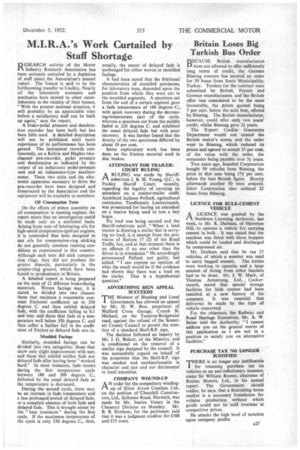M.I.R.A.'s Work Curtailed by Staff Shortage
Page 29

If you've noticed an error in this article please click here to report it so we can fix it.
RFSEA RC H activity of the Motor Industry Research Association has been seriously curtailed by a depletion of staff states the Association's annual report. The 'reason is said to be the forthcoming transfer to Lindley. Nearly all the laboratory assistants and mechanics have moved to other establishments in the vicinity of their homes. "With the present national situation, it will probably be an appreciable time before a satisfactory staff can be built up again," says the report.
A brake-pedal pressure and deceleration recorder has been built but has been little used. A detailed description will not be published until more experience of its performance has been gained. The instrument records continuously, on a Kelvin and Hughes twochannel pen-recorder, pedal pressure and deceleration as indicated by the output of an inductance pedal-pressure unit and an inductance-type accelerometer. These two units and the electronic apparatus necessary to drive the pen-recorder have been designed and Constructed by the Association and the equipment will be available to members.
OH Consumption Tests On the effects of piston assembly on oil consumption in running engines, the report states that an investigation could be made only on a statistical basis. Arising from tests of lubricating oils for high-speed compression-ignition engines, it is contended that tests designed to test oils for compression-ring sticking do not generally simulate running conditions as experienced in this country. Although such tests did stick compression rings, they did not produce the groove deposits, particularly in the scraper-ring groove, which have been found to predominate in Britain.
A detailed report is being prepared on the tests of 12 different brake-facing materials. Woven facings may, it is stated, be divided into two classes: those that maintain a reasonably constant frictional coefficient up to 350 degrees C." and then exhibit delayed fade, with the coefficient falling to 0.1 and less; and those that fade at a temperature well below 350 degrees C. and then suffer a further fall in the coefficient of friction as delayed fade sets in, Moulded Facings Similarly, moulded facings can be divided into two categoiies: those that show only slight improvement with use; and those that exhibit neither fade nor delayed fade after having been "worked hard." In most instances, fade occurs during the first temperature cycle between 180 and 300 degrees C., followed by the usual delayed fade as the temperature is decreased.
During the second cycle, there may be an increase in fade temperature and a less prolonged period of delayed fade, or a complete absence of both fade and delayed fade. This is brought about by the "heat treatment" during the first cycle. If the maximum temperature of the cycle is only 250 degrees C., then, usually, the extent of delayed fade is unchanged for either woven or moulded facings.
It had been noted that the frictional characteristics of moulded specimens, for laboratory tests, depended upon the position from which they were cut in the moulded segments. A specimen cut from the end of a certain segment gave a fade temperature of 180 degrees C., with quick recovery during the decreasing-temperature part of the cycle, whereas a specimen cut from the middle faded at 220 degrees C. and exhibited the usual delayed fade but with poor recovery. It was further found that the density of the two specimens differed by . about 10 per cent.
Some exploratory work has been done on the friction material used in disc brakes.
ATTENDANT FOR TRAILER: COURT RULING
A RULING was made by Sheriff!" substitute J. B. M. Young, Q.C., in
Paisley Sheriff Court, recently, regarding the legality of carrying an attendant on a tractor-trailer outfit.
Archibald Jackson Pollock, agricultural contractor, Tandlernuir, Lochwinnoch, was .prosecuted for having no attendant on a tractor being used to tow a hay bogie.
No load was being carried and the Sheriff-substitute said: "When a land tractor is drawing a trailer that is carrying no load, it is exempt from the pro vision of Section 17 (2) of the Road Traffic Act, and at that moment there is no offence if no one other than the driver is in attendance." He accordingly pronounced Pollock not guilty, but added: "3 can express no opinion of what the result would be if the evidence had shown that there was a Toad on the trailer. That is a hypothetical question."
ADVERTISING SIGN APPEAL SUCCEEDS
THE Minister of Housing and Local Government has allowed an appeal by Mr. H. W. Best, proprietor of Walford Cross Garage, Creech St. Michael, on the Taunton-Bridgwater road, against the refusal of the Somerset County Council to permit the erection of a standard Shell-BY. sign.
The decision followed an inquiry by Mr. J. G. Birkett, of the Ministry, and is conditional on the removal of a similar sign designed by the council. It was successfully argued on behalf of the proprietor that the Shell-B.P. sign was modest and unobjectionable in character and size and not detrimental to local amenities.
COMPANY WOUND-UP
A N order for the compulsory winding!" up of Silver Arrow Coaches, Ltd., on the petition of 'Churchill Construetors, Ltd., Salhouse Road, Norwich, was made by Mr. Justice Vaisey in the Chancery Division on Monday. Mr. B. B. Stenham, for the petitioner, said that it was a judgment creditor for £100
and f13 costs. •




















































































